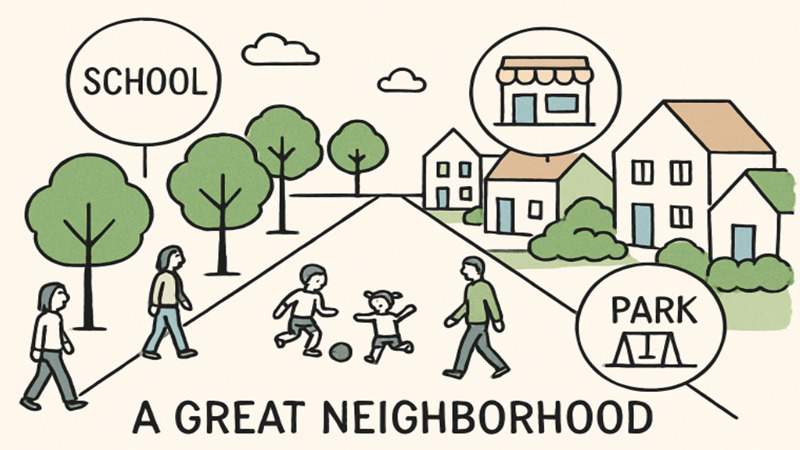Key Takeaways
- Assess safety by reviewing crime statistics and observing community engagement.
- Evaluate the quality of local schools, even if you don’t have children.
- Consider proximity to amenities, public transportation, and employment opportunities.
- Observe signs of community involvement and neighborhood upkeep.
- Research future development plans and economic growth indicators.
Choosing the right neighborhood is often just as important as selecting the perfect home itself. The community you settle in can shape your lifestyle, daily satisfaction, and the long-term value of your property. That’s why partnering with trusted local experts like Fountain Valley CA real estate agents Lily Campbell Team can give you a significant advantage when discovering the ideal area that matches your needs.
While a house’s architecture and amenities matter, the environment around it influences your experience. Elements such as street safety, quality schools, and access to amenities significantly influence satisfaction and resale value. A great neighborhood supports comfort and smart investing.
Understanding these factors before making a purchase helps you make informed, rewarding decisions. Recognizing the signs of a good community helps identify opportunities, avoid regrets, and settle into your new area. The right location can boost property value, offer peace of mind, and improve daily life.
With many neighborhoods to choose from, focusing on safety, community, amenities, and growth factors will guide your success in any market. Below are key considerations for finding the best neighborhood for you.
Safety First
Homebuyers tend to prioritize safety—and for good reason. Living in a secure neighborhood fosters a sense of peace of mind and a better day-to-day experience. Start by checking up-to-date crime rates via official city, police, or community websites. Many towns provide interactive crime maps to help you evaluate specific blocks and incident frequency. Also, look for signs of well-lit streets, neighbors outside in the evenings, and visible neighborhood watch signs; all are strong indicators of a safe and cohesive environment. Learning about community safety measures, such as local Nextdoor groups or block watch programs, can also offer valuable insight.
Educational Opportunities
Even for buyers without children, the quality of nearby schools remains a crucial factor, as it directly influences property values and neighborhood stability. Areas with top-rated public schools are highly sought after and usually experience more stable home prices. Use resources like GreatSchools.org to look up district ratings, parent reviews, and school performance metrics. You’ll find that excellent schools attract engaged families, which helps boost the sense of community and drives consistent growth in the area.
Access to Amenities
Convenience shapes daily life. Proximity to a diverse range of amenities, such as parks, recreation centers, shopping plazas, restaurants, and health services, can make a substantial difference. Evaluate how far you’ll have to travel for groceries, dining, fitness centers, and medical appointments. Walkability is another factor worth considering to check an address’s walkability rating. Neighborhoods featuring a mix of services and leisure activities generally appeal to a wider variety of buyers, enhancing your home’s long-term investment potential.
Public Transportation and Commute
If your routine or work location requires a daily commute, access to public transportation or major highways is essential. Check for nearby bus or train lines, reasonable commute times, and traffic patterns during rush hour. Homes in areas with efficient transit options tend to maintain higher values and attract residents looking for cost-effective alternatives to driving. Additionally, shorter commutes or multiple transit options can dramatically improve your work-life balance and satisfaction with your living situation.
Community Engagement
An involved community usually translates to a safer, friendlier, and more vibrant neighborhood experience. Investigate whether the area hosts regular events, farmers’ markets, or block parties. Explore social media groups, local newsletters, or websites like Meetup to gauge community spirit and active participation. Highly engaged residents often work together to maintain neighborhood standards, advocate for shared interests, and provide mutual support, all of which enhance your overall sense of belonging.
Property Maintenance and Aesthetics
First impressions matter. Well-maintained streets, manicured lawns, and tidy public spaces indicate strong neighborhood pride and responsible ownership. The presence of attractive landscaping, clean sidewalks, fresh paintwork, and minimal visible disrepair suggests that residents take pride in their properties and the shared environment. Such upkeep signals a stable investment and a pleasant living atmosphere, which future buyers will appreciate as much as you do.
Future Development and Economic Growth
Explore any proposed developments or ongoing projects in your prospective neighborhood. New infrastructure, retail centers, or transit lines can greatly enhance appeal and property values—but beware of overdevelopment, which may change the area’s character or create future congestion. Local municipal or city planning department websites will list upcoming projects, helping you anticipate changes. Understanding the economic outlook and job growth in the area can also improve your confidence in long-term appreciation.
Conclusion
The process of evaluating a great neighborhood relies on balancing logical research with personal observation. By focusing on safety, school quality, amenities, access, local participation, curb appeal, and prospects, you’ll be well-equipped to make a decision that benefits both your lifestyle and investment portfolio. Approach your search thoughtfully and leverage every resource available to ensure you find the perfect fit for your next chapter.
For more info visit Pocketmemories
